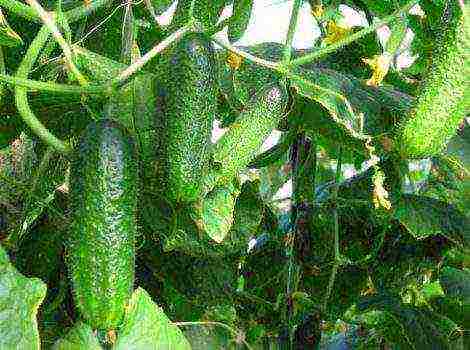Content
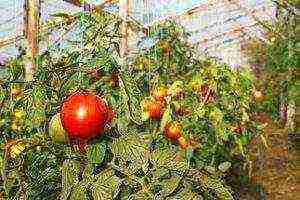
Growing tomatoes in a greenhouse - a good option business for experienced gardeners. By choosing the right varieties and investing in equipment, you can collect good harvests several times a year.
Demand for quality tomatoes high, they can be offered to retailers and catering establishments, as well as sold through their own points in the market.
…
Ideal greenhouse for tomatoes
Summer greenhouses or hotbeds are often installed on personal plots. They are suitable for protecting plants during frosts, accelerate fruiting, allow you to grow especially thermophilic varieties. Such greenhouses can be built on a wooden or metal frame and covered with foil. The greenhouse requires annual renovation, but it is quite cheap. Suitable only for seasonal cultivation in soil.
For year-round cultivation of tomatoes capital buildings are neededequipped with a heating system. Such greenhouses are erected on a solid metal frame with an anti-corrosion coating. Glass or polycarbonate is used as a coating.
The latter is suitable for arched greenhouses, sheets can be bent and cut without fear of damage. In regions with cold climates double glazing recommended... The air between layers of glass or polycarbonate creates a thermos effect, which reduces heating costs.
For year-round cultivation, a greenhouse with a pitched roof is more convenient. Sizes vary from 100 to 500 sq. m... Industrial greenhouses are even larger, with an average size of about 1000 sq. m.
 Such structures imply overhead cultivation, hydroponic or aeroponic... A significant disadvantage of tomatoes grown in a nutrient solution is the recognizable watery taste and the absence of a characteristic aroma.
Such structures imply overhead cultivation, hydroponic or aeroponic... A significant disadvantage of tomatoes grown in a nutrient solution is the recognizable watery taste and the absence of a characteristic aroma.
An ideal tomato greenhouse should be tall enough. The north wall can be laid out with cinder blocks or timber. A blank wall will protect the landings from the wind and will help keep warm. The preferred design is with a pitched roof, on which snow does not linger.
Pros and cons of business
Growing tomatoes indoors has many advantages... Among them:
- high demand for tomatoes, increasing in the autumn-winter season;
- heated greenhouses allow for several harvests per year;
- there are many varieties designed specifically for greenhouses;
- tomatoes stored long enoughthat minimizes losses;
- the harvested crop can be sold independently, through retail outlets on the market or the Internet, as well as sold through retail chains, catering and wholesale buyers.
Despite the good prospects for entrepreneurs, business has some drawbacks.
Among the most significant:
- high costs of heating the greenhouse in the cold season;
- growing tomatoes on an industrial scale should only be done by people with experience in plant growing;
- for work with retail registration of a legal entity is required and obtaining a veterinary certificate for products;
- in the summer, competition from the owners of outdoor tomato growers increases.
Choosing a variety for closed ground
In the greenhouse, it is preferable to grow hybrids specially designed for indoor use. It is better to choose tall, branched varieties. On such a bush many fruits ripen at the same time, which increases the productivity of greenhouses.Tall bushes can be combined with smaller ones planted around the perimeter. This arrangement will allow you to make optimal use of the scarce space.
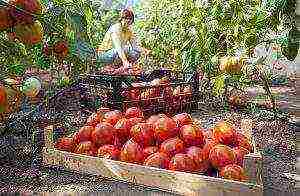 For indoor use, both early and late varieties are suitable. In the middle lane, it is not recommended to plant especially sweet hybrids of southern selection, they are very sensitive to temperature fluctuations and can be affected by pests.
For indoor use, both early and late varieties are suitable. In the middle lane, it is not recommended to plant especially sweet hybrids of southern selection, they are very sensitive to temperature fluctuations and can be affected by pests.
Specialists recommend choosing hybrids, zoned for a specific region. The varieties of Russian selection, as well as American, Dutch and Polish tomatoes, have proven themselves very well.
When choosing the right variety, it is worth considering:
- Yield... Multiple varieties will significantly increase income.
- Fruit ripening time... The shorter the growing season, the more profitable the business.
- Disease resistance... The best hybrids are not affected by pests and do not require constant insecticide treatment.
- Taste qualities of tomatoes... Consumers prefer fleshy fruits with a bright sweetish taste and pronounced aroma.
- Fruit size and color... Tomatoes of medium size, deep red, pink or yellow, are in great demand among buyers.
- It is advisable to choose varieties with fruits that tolerate storage and transportation well.
Among the most popular, industrial varieties of tomatoes for greenhouses can be noted:
- Early and mid-season varieties: Gift, Aksinya, Cherry, Evpator, Kostroma. Palenque.
- Hybrids with a shortened growing season: Verlioka, Rhapsody, Caspar, Sprinter, Etude, Farmer.
- Fruits with a particularly intense taste: Honey Spas, Pink Honey, Orange King, Asteroid, Lady, Ballerina.
Other tomato varieties recommended for greenhouses presented on our website:
ChocolateQishmishYellow pearDomes of RussiaPride of SiberiaPink ImpressionNewbieWonder of the WorldPresident 2De Barao GiantMeaty handsome
.
Having chosen the right variety, it is worth concentrating on it. Industrial cultivation of tomatoes in a greenhouse not focused on experimentation, but to increase yields. Professionals usually grow no more than 2-3 types of tomatoes at a time.
Greenhouse equipment
In small farm greenhouses, it is better to grow tomatoes in the ground. Their taste is much higher, which makes it possible to sell products at a good mark-up.
Greenhouse must be equipped with a ventilation system and automatic drip irrigation. Tomatoes are sensitive to moisture levels, but they do not like stagnant water in the soil. On hot days, shading is required using special curtains that cover the south side of the greenhouse.
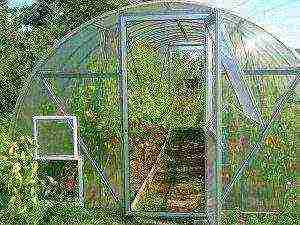 The heating system can be different. Industrial greenhouses heated with built-in boilers and pipes laid underground. Farm structures can be heated with air heaters, stove stoves and even bonfires. The use of biofuels from a mixture of rotted manure and straw will also help.
The heating system can be different. Industrial greenhouses heated with built-in boilers and pipes laid underground. Farm structures can be heated with air heaters, stove stoves and even bonfires. The use of biofuels from a mixture of rotted manure and straw will also help.
To maintain the desired microclimate in winter, open tanks with diluted mullein are installed in the greenhouse. Vapors activate the process of photosynthesis necessary for good fruiting.
Tomatoes in a greenhouse need light, nutritious soil, in which complex mineral fertilizers are regularly applied. Top dressing from a mixture of superphosphate, potassium salt and ammonium nitrate paid every two weeks... Lack of nutrients slows down the formation of ovaries and fruit ripening.
How to calculate profitability?
Before you start growing tomatoes, it is important to draw up a detailed business plan... It will help you correctly calculate the profitability of your future business and accurately take into account all the upcoming costs. The consumable part includes:
- lease of a plot of land or its purchase;
- construction and equipping of a greenhouse;
- purchase of seeds or seedlings;
- purchase of fertilizers and agricultural implements;
- registration of a legal entity and registration of product certificates;
- transportation of finished products to the point of sale.
Useful video:
The profit depends on the volume of sales and the method of implementation. The most profitable option is sale of tomatoes through retail chains or catering establishments.
Cafes and restaurants need not so much cheap as quality products. Sales of the crop to wholesale buyers are also possible, but in this case the margin is significantly reduced.
Substandard can be taken for processing (making sauces, pastas, juices).
Much also depends on the timing of the sales. In winter, the margin increases by 1.5-2 times. This is due to a decrease in supply and an increase in production costs. Before starting winter cultivation, you need to estimate the cost of heating.
In particularly cold regions, the high cost of electricity can significantly reduce profitability. Many farmers prefer to extend the tomato cultivation period until November and suspend production in the winter.
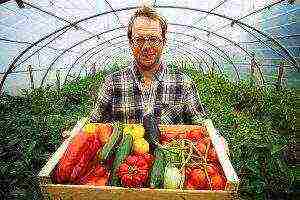 According to marketers, the average business profitability on the industrial cultivation of tomatoes in the greenhouse fluctuates from 50 to 70%.
According to marketers, the average business profitability on the industrial cultivation of tomatoes in the greenhouse fluctuates from 50 to 70%.
In lean years, it can increase, in a period of great competition from private households, it can decrease. Expansion of the greenhouse economy and distribution channels will help increase profitability.
Other popular crops for the greenhouse business, about which you can find out in more detail on our website: berries, flowers, herbs, cucumbers and other vegetables.
So that growing tomatoes in a greenhouse as a business does not go bankrupt, it is important to calculate the costs carefully and future earnings. You can start work from one small greenhouse, gradually increasing the momentum. It will help to attract loans and subsidies that are possible when registering a legal entity.

Buying greenhouse tomatoes in early spring, I, and probably many gardeners, have always been interested to know how they are grown. It is clear that in a greenhouse, with lighting, heating, etc. But I still wanted to look with at least one eye - and I succeeded!
The veil of secrecy was opened to me in the greenhouse complex of the SPK "Rassvet" which once thundered throughout the USSR. K.P. Orlovsky. In this kingdom of tall tomatoes with real vines of 18 meters each, plants are grown from December to November, taking off the first batch of crops at the end of March! Think 18 meters is a typo?
At first, I also could not imagine such plants, until the agronomist of the enterprise Tatyana STELMAKH took me on an excursion to one of the greenhouses. By the way, at first glance it may seem that in front of you are the usual tall tomatoes of 2.5 m.But if you look closely, you notice that everything is not so simple.
Here we grow Dutch Torero hybrids, - says Tatiana Nikolaevna.
The seeds were sown for seedlings on December 10 in “fingers” made of mineral wool, then they were sown into similar cubes measuring 15 × 20 cm and, finally, they were placed in a greenhouse on meter-long mineral blocks (each with 4 bushes). Then the tomatoes sprout into the block by their roots. So it is clean in greenhouses, and blocks with cotton wool are easier to transfer than peat.
How is it possible to grow such gigantic whips, and then also "hide"? - These are the features of the hybrid.
The working part of the plant, where the fruits are formed, is about 2.5-3 m. It can be seen in a vertical garter. When the lash yields the harvest, remove the leaves from this part of it, lower the lash and hang it horizontally along the rack. In the vertical part, a new crop is formed, then this part of the trunk also grows old - so it turns out that by the end of the season the total length of the stem reaches 15-18 m.
See also: Giant tomatoes - giant tomatoes without a greenhouse in the open field
How do you shape and thin out the plants?
Apart from manipulating the length of the stem, everything is standard. We grow most of the bushes in one stem, but every 4th, if a strong stepson comes out after the 3-4th brush, we start up in two stems.On the vertical working part, we regularly remove stepchildren, breaking them closer to the stem: gray rot may develop on the hemp. For the rest, we look at the situation: in the spring and autumn we leave less leaves, in the summer, in the heat, more. Usually we also remove the first or second leaf above the fruit brush - choose the one that covers it (otherwise the tomatoes will ripen for a long time). We remove the leaves, while they are small, in order to less injure the plant. It is better to carry out the procedure during the day, so that the wounds dry out in the heat and heal.
And we also remove unnecessary ovaries if we see that the brush cannot form each fruit in the same way. Otherwise, they will take food away from each other and remain small. The optimal number of fruits per cluster is 3-4.
Are you pinching the tops?
Necessarily. And we pinch so that two leaves remain above the upper brush. We do this around the end of August, so that by the end of October all the brushes are poured. If you pinch it later, in mid-September, the top fruits will remain small until harvesting.
How do you tie tomatoes?
Above each row is a strong wire with hooks, on which a long twine is wound for a garter. As the lashes grow, we lower it. We also try to tie up large brushes, otherwise, due to the twig break, the food to the fruits will be worse.
Reference by topic: Growing dwarf varieties of tomatoes and cherry tomatoes in a greenhouse.
Top dressing of greenhouse tomatoes
There is no customary watering at the plant: a nutrient solution with a small dose of micro- and macroelements - potassium, nitrogen, calcium, magnesium, phosphorus, as well as iron, zinc, manganese, boron, copper - is supplied to tomatoes through a drip system. According to the results of chemical analysis, any missing element can be added.
Although the "flaw" is sometimes immediately visible: for example, with a lack of magnesium, the lower leaves become stained. Potassium is especially needed for pouring fruits, so there is always a little more of it than other components.
But they take into account: the more dressings, the sweeter the fruits, but smaller. The volume of the solution depends on the state of the plants and the weather: in sunny bush it reaches 3 liters per day, in cloudy - 0.7 liters.
Below are other entries on the topic "Cottage and garden - do it yourself"
Growing raspberries using the "long shoot" technology: Harvesting raspberries in May or ... Propagation by air layering - how is it correct ?: How plants are propagated by air layering "There is ... Irrigation technology of growing tomatoes: How to grow tomatoes without irrigation ... Onion fly - how to get rid of: Fighting onion fly - ... Grapes: work in June: Grape care in June In ... Late blight - the main thing is not treatment but prevention: The best remedy for late blight is ... Peony flowers - propagation by layering: Peonies - by layering Last fall ...
The main difference is that it is necessary to spend an impressive amount on the industrial cultivation of tomatoes in a greenhouse. If you are not ready to go for it, it is better to try to breed them on your own. However, it is worth remembering that this vegetable is very whimsical, and caring for it is rarely simple. If your financial situation allows you to use a modern greenhouse complex, then you can be congratulated, because in such a place you can harvest crops even for a whole year.
How to grow tomatoes in such premises? First you need to disinfect the ground and plant seeds for seedlings in advance. This point is key, because only with the right seedlings can you grow and harvest a good harvest. Thorough care, optimal temperature and uniform illumination - all this is the real key to success.
Do not forget about some general recommendations that must be strictly followed:
- Before planting, you need to prepare the soil. It should be porous and moisture permeable.
- Saplings should be tightly and securely tied, and also be at a certain distance from each other.
- From time to time, the bushes need to be formed by removing excess leaves and periodically tying up again.
- Remember that you always need to monitor humidity, temperature and systematic watering, even though such complexes have automatic systems.

Everything that is written above proves once again how important it is to take into account a huge number of factors in order to grow high-quality tomatoes.
Be careful, and have a good harvest!
In this section I will try to post interesting video about tomatoeswhich I will find on the Internet. You can send your video or link to a video that you liked on other sites.
Here are some videos about growing tomatoes in industrial greenhouses in the west. It is without translation.
There are a few things to note in these videos.
- Tomatoes can grow almost indefinitely and the stems are easy to bend like hoses.
- They grow in simple bags of soil where the nutrient mix is fed.
- Requires constant pinching and shaping.
- Limit the number of flowers per brush.
- Pollinated with the help of bumblebees.
- When harvesting, the entire cluster is removed, like in grapes.
Of course, we will not be able to create such conditions on our plots, but we do not need this, we will only adopt what we can apply, our task is to grow ecologically clean, tasty tomatoes.
I can only imagine what would have happened to my tomatoes if they were passed through a conveyor belt with washing, and only tomato juice would probably have reached the packaging.
What do you think?
(
votes, average:
out of 5)
Loading …
•


